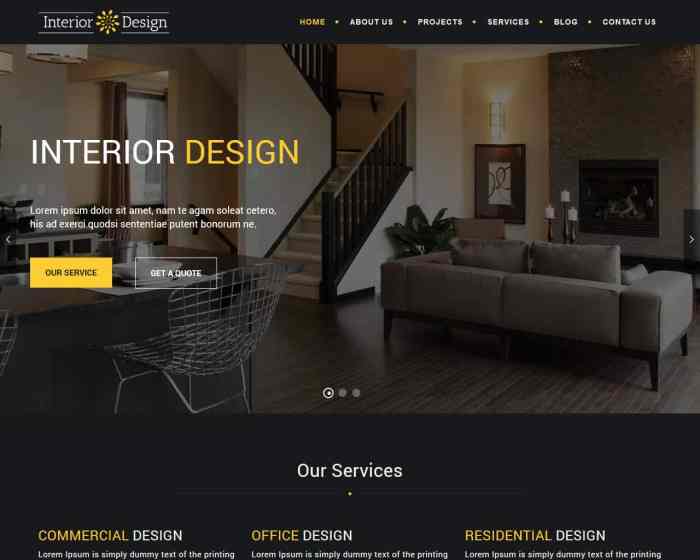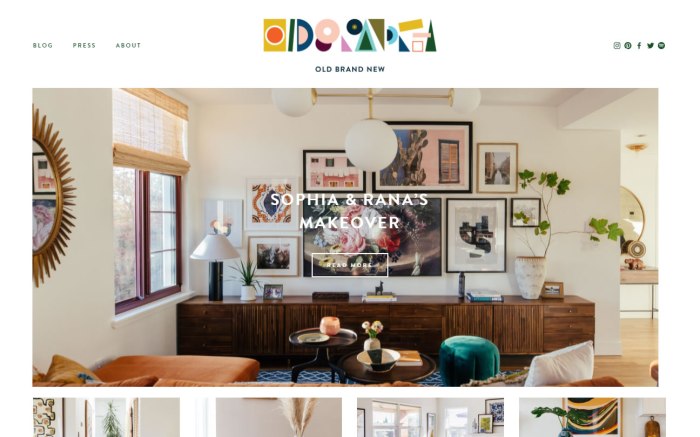Designing Success: Exploring the World of Interior Design Websites
Delving into the realm of interior design websites, this introductory paragraph aims to capture the reader's attention by highlighting the importance of an online presence in the design industry. From showcasing portfolios to attracting clients, these websites play a crucial role in enhancing brand visibility and credibility.
As we delve deeper into the essential features, content strategy, user experience, and interface design of interior design websites, let's uncover the key elements that contribute to a successful online presence in the competitive design landscape.
Importance of Interior Design Websites

Having a well-designed website is crucial for interior design businesses in today's digital age.
Interior design websites play a significant role in enhancing brand visibility and credibility, allowing businesses to showcase their expertise and style to a global audience.
Showcasing Portfolios and Attracting Clients
One of the key functions of interior design websites is to showcase portfolios of past projects. This allows potential clients to view the quality of work, design aesthetics, and range of services offered by the business.
By displaying a diverse portfolio on the website, interior design businesses can attract clients who are impressed by the showcased work and are looking for similar design solutions for their own spaces.
Essential Features for Interior Design Websites

When creating an interior design website, it is crucial to incorporate key features that will enhance the user experience and showcase your design work effectively. From high-quality images to easy navigation, these elements play a significant role in attracting and engaging visitors.
High-Quality Images and Visuals
One of the most important features of an interior design website is the use of high-quality images and visuals. These images serve as a visual representation of your design style and expertise, allowing visitors to get a glimpse of your work.
Clear, crisp images can help potential clients envision their own spaces and make them more likely to reach out for your services.
Easy Navigation
Another essential feature for interior design websites is easy navigation. Visitors should be able to explore your portfolio, services, and contact information with ease. A well-organized menu and intuitive layout can help users find what they are looking for quickly, improving their overall experience on your website.
Responsive Design
Responsive design is crucial for interior design websites as it ensures that your site looks great and functions well on all devices, including smartphones and tablets. With the increasing use of mobile devices, having a responsive website is essential to reach a wider audience and provide a seamless browsing experience for all visitors.
Content Strategy for Interior Design Websites
When it comes to interior design websites, having a solid content strategy is crucial for attracting and retaining visitors. The type of content you include can greatly impact the overall user experience and engagement on your site. Here are some key points to consider when developing a content strategy for your interior design website:
Type of Content
- Create visually appealing galleries showcasing your past projects, including before and after photos.
- Include detailed descriptions of your design process, highlighting key features and materials used.
- Provide informative articles or blog posts on design trends, tips for interior styling, and DIY projects.
- Incorporate client testimonials and reviews to build credibility and trust with potential customers.
- Showcase your design expertise through case studies that demonstrate your problem-solving skills and creativity.
Tips for Engaging Content
- Use high-quality images to capture the attention of visitors and showcase your design work effectively.
- Write in a conversational tone to connect with your audience and make the content more relatable.
- Include interactive elements such as quizzes, polls, or design challenges to encourage visitor engagement.
- Utilize best practices to improve visibility and reach a wider audience through search engine rankings.
- Regularly update your content to keep visitors coming back for fresh ideas and inspiration.
Role of Blogs and Articles
- Blogs and articles can help establish your expertise in the field of interior design and showcase your unique perspective.
- By providing valuable insights and tips, you can attract a loyal following of readers who trust your advice and recommendations.
- Regularly publishing new blog posts can also drive traffic to your website and improve your search engine rankings over time.
- Engaging with your audience through comments and discussions on blog posts can help build a sense of community around your brand.
- Consider guest blogging on other relevant websites to expand your reach and connect with new audiences.
User Experience and Interface Design
User experience plays a crucial role in the success of an interior design website. It directly impacts how visitors interact with the site, navigate through the content, and ultimately decide to engage with the services or products offered. A well-designed user experience can lead to increased engagement, higher conversion rates, and improved overall satisfaction for users.
Importance of Intuitive Navigation and Clear Calls to Action
Effective interior design websites prioritize intuitive navigation and clear calls to action to guide users through the site seamlessly. By organizing content logically, providing easy-to-use menus, and ensuring quick access to key information, websites can enhance user experience and encourage visitors to explore further.
Clear calls to action prompt users to take specific actions, such as contacting the designer, requesting a quote, or browsing portfolio projects, leading to increased conversions and engagement.
- Intuitive navigation: Designing a clear and organized menu structure, using breadcrumbs for easy backtracking, and implementing search functionality for quick access to information.
- Clear calls to action: Utilizing visually prominent buttons, strategic placement of contact forms, and compelling language to encourage user interaction and engagement.
- Interactive elements: Incorporating interactive features like sliders, galleries, and virtual tours to showcase design work and engage users visually.
- Responsive design: Ensuring the website is optimized for various devices and screen sizes to provide a seamless user experience across desktop, tablet, and mobile platforms.
Final Thoughts
In conclusion, interior design websites serve as powerful tools for design businesses to showcase their work, attract clients, and establish credibility. By incorporating essential features, engaging content, and user-friendly interfaces, these websites can elevate brands and create lasting impressions on visitors.
As the digital landscape continues to evolve, staying ahead with a well-designed website is essential for success in the interior design industry.
User Queries
How can interior design websites enhance brand visibility?
Interior design websites create a platform for design businesses to showcase their work, expertise, and style, thereby increasing brand visibility among potential clients and industry professionals.
What type of content should be included on interior design websites?
Content on interior design websites should include high-quality images of past projects, informative articles on design trends, client testimonials, and a blog section for sharing insights and expertise.
Why is user experience crucial for the success of an interior design website?
User experience plays a vital role in keeping visitors engaged, guiding them through the website seamlessly, and ultimately converting them into potential clients. A well-designed user experience can enhance brand trust and credibility.